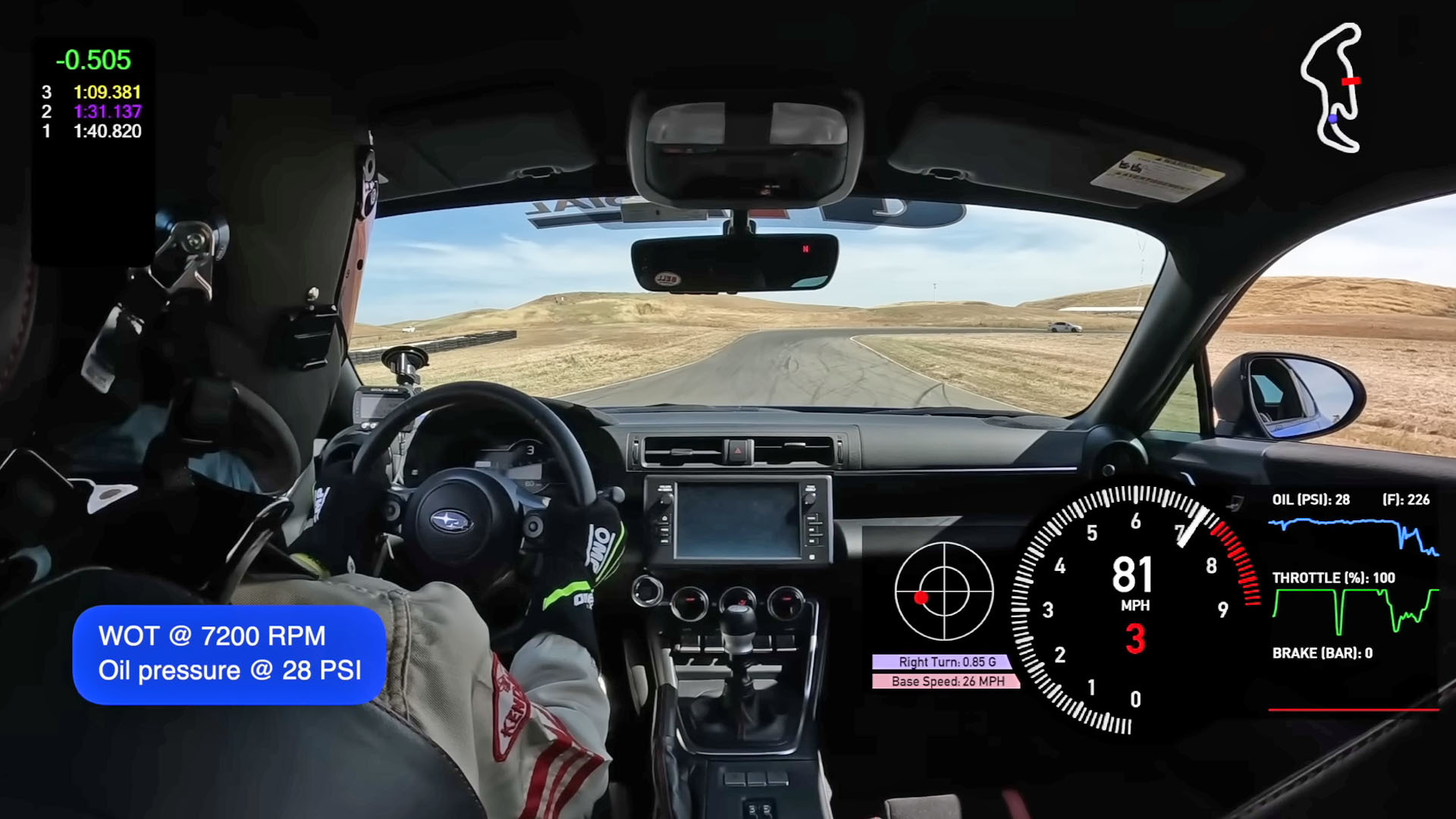

Toyota warranty issues have highlighted at least two engine failures in the GR86 sports car, which is closely related to the Subaru BRZ and powered by the Subaru FA24D four-cylinder engine. Owners have reported potential issues with the vehicles’ lubrication system, and now at least one owner has decided to dig deeper.
2022 Subaru BRZ owner Brian Armstrong, who conducted the testing and spoke with The Drive, gets a few things out of the way first. He claims to personally know three separate individuals who have blown their cars’ FA24 engines on track, which drove him to do this testing. He described them as meticulous owners who have even installed aftermarket oil coolers. To try and diagnose a potential problem, Armstrong rigged up two oil pressure sensors with data-logging capability to his and anothers’ vehicle in separate locations on the engine. When tied into the vehicle’s CAN bus, this data can be overlayed with engine RPM and other information. For the record, it’s unclear to him whether or not loose RTV is causing failures (that has been citied as a possible issue in these cars), and he isn’t necessarily focusing on that for now.


The primary testing of the three cars was completed on the same day at Thunderhill Raceway Park in Willows, California, with most of the analysis completed on the Thunderhill West portion of the track. Along with the two new FA24D-equipped cars, an older FA20-powered Subaru BRZ was tested as well as a control reference. Other testing was done at Thunderhill’s five-mile circuit on a different day as well.
Armstrong’s testing of new FA24D-powered cars finds consistent drops in oil pressure around hard right-hand corners, especially with a fast turn-in or elevation change. Slower, less intense right-hand corners do not seem to cause any dips. In one instance, around Turn 5 on Thunderhill East, a pressure drop from 62 psi to 28 psi is recorded, which is a massive 34 pounds of pressure at high RPM. Elevation changes in combination with right-hand corners seem to be especially tricky for the vehicle’s lubrication system to keep up with, as the drop in pressure lingers for some time in these instances.
“We found [the] FA24 provides robust oil pressures on straights and left-hand turns, but we’ve been able to consistently reproduce pressure drops on right-hand corners,” he told me. “We believe these pressure drops are significant enough to cause bearing damage, even if not an immediate failure.”



The older FA20-equipped BRZ seems to suffer from a similar issue around right turns, but not nearly to the extent of its larger 2.4-liter cousin. There is a brief downward spike here or there on the 2017-spec car, but nothing as consistent or high in magnitude as in the newer cars.
Armstrong’s car has not had its pan dropped to check for RTV, the sealant that has been cited as a potential failure point, but the other Toyota tested in the video has. Both cars have lightly modified suspension and new tires, although Armstrong states the new rubber is not as sticky as what’s available on the car from the factory. The only major modification to both vehicles’ lubrication systems is oil coolers. Armstrong provides detailed specifications of each vehicle in the video.

The testing in terms of new cars only covers one BRZ and one new GR86. More research in different conditions should be completed before anyone draws any damning conclusions. However, the fact that the results were replicated with such ease by an amateur driver is noteworthy. Both cars are extremely similar in spec and the testing was done on the same day on the same track with identical instrumentation. What Armstrong is showing here may not be a smoking gun, but it’s a strong indication that the FA24D’s lubrication system could have shortcomings during high-performance driving and that RTV-related blockages or restrictions could exacerbate a situation where the engine is already starved for oil.
Armstrong plans to continue testing his car with aftermarket components to potentially relieve some of these oil pressure drops. “We’re going back to Thunderhill on July 1 and we will be doing the following test: My car with Killer B prototype [oil pan] baffle and the same 5W30 Motul 8100 oil,” he told me. A regular FA24-equipped car without the baffle will also be tested.
In terms of his advice to owners, Armstrong is clear. Make sure your oil is at the right level, install an oil cooler if you’re seeing high temps, and consider a baffle in the pan as well. Likewise, using a heavier-weight oil could be a good move, at least on the track. “the GR Cup teams I’ve talked to are using 5W40,” he told me.
Despite the lengths necessary to keep his engine safe on track, Armstrong noted that none of this necessarily affects his feelings about his car. “I love this platform and want it to be reliable for people to enjoy,” he told me. That means testing new parts, being objective on what he finds, and continuing to search for answers. “I want to encourage other people to approach these types of problems in a systematic way, with conclusions supported by real evidence.”
The Drive has reached out to Toyota and Subaru for comment on Armstrong’s findings, but we have yet to hear back from either as of publishing.
Got a tip or question for the author? Contact them directly: peter@thedrive.com